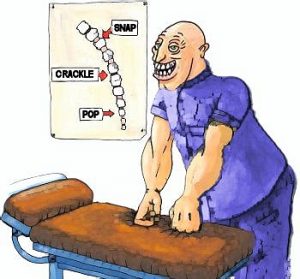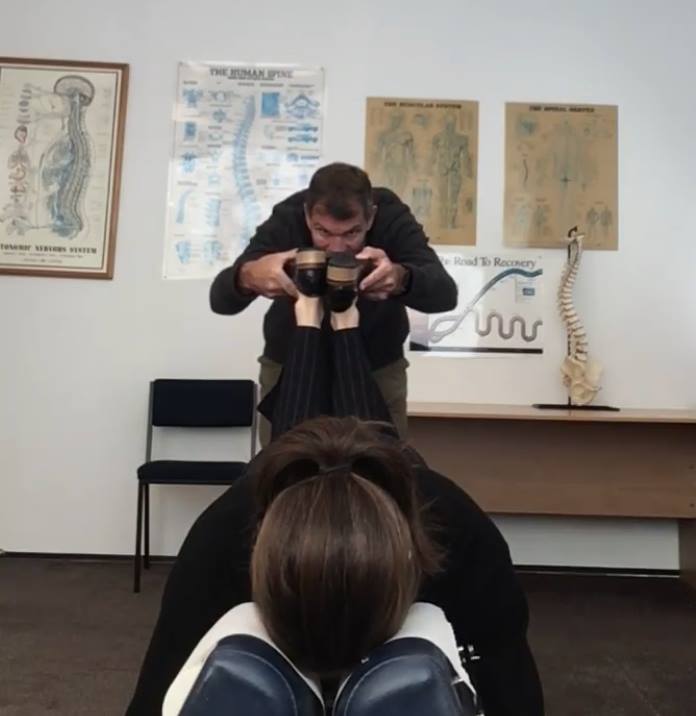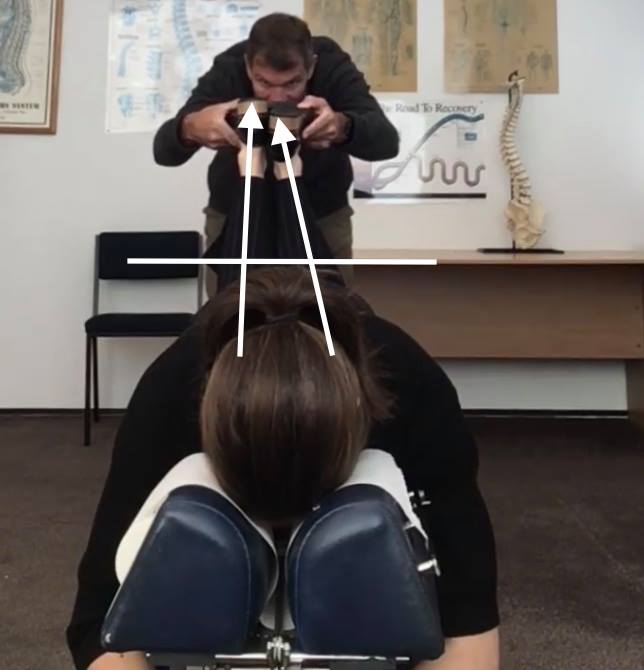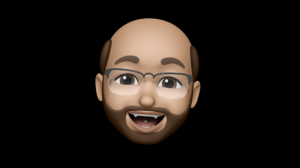Some thoughts on getting a chiropractor involved with your rehab, an old post from FaceBook and how to pick a professional.
As happens from time to time, my clinical load has me thinking about the role of different professionals in the rehabilitation of patients. These last few weeks have been interesting as I have had a number of the chiropractic faithful attend for; second opinions (patient generated due to dissatisfaction), physiotherapy reviews (requested by the treating chiropractor), clinical reviews and full treatment review consultations.
I say the “chiropractic faithful” as, those of the community who find their treatment effective for their musculoskeletal problems, tend to be frightfully faithful to the theology that bones of the spine become subluxated/subluxed (sit slightly out of place) and that the chiropractic adjustment “returns” them to alignment. This concept of Bones Out Of Place (Referred to as BOOP by Jarod Hall – physiotherapist) has not been well supported by research, with even chiropractic clinics confirming that this is not the answer to the “pop” or “crack” that you hear at times when a manipulation is performed.
While a number of science based practitioners out there are solidly “anti-chiropractic”, I must say that my experience at a corporate level, as well as anecdotally within my own clinic and professional sphere, has lead me to believe that there are good and bad chiropractors, in just the same way as there are some terrible doctors (integrative/CAM/functional), physiotherapists and even surgeons (e.g. meniscetomies on 60+ year old knees with osteoarthritis). I would say my experience is that more of them hold to DD Palmer’s original vitalistic approach to chiropractic, than accept the modern clinical sciences explanation for care, but at times I do wonder something similar about my own profession.

Logo for The Good Guys Shops (Australia)
In the last few weeks, however, I had a patient referred by a chiropractor that really felt that their treatment approach was not working and the patient was seeking something more, and a chiropractor providing an exercise based rehabilitation approach focusing on desensitising a patient’s kinesiophobia (fear of movement/activity) and improving their self efficacy. For those that don’t know, these are definitely some of the “good guys”. If you are seeing a chiropractor who is using good evidence based treatment like these guys, your symptoms should be getting better and you should be increasing your independence and self management with decreasing need for passive/hands on treatment.

Credit: Home on the Grange – WordPress
Mean while, I had another client with a 20 year+ history of ongoing “maintenance” treatment with increased frequency when “something went out”.
This sadly reminded me of a post I put on FaceBook in August 2018 which, when I think of it now, was my first social media published review. I had a number of people ask to be able to share the post (I had it locked down pretty tight then), so I thought that this might be a better forum and chance to put this information out there.
The discussion below was following seeing a video of a chiropractor performing a “maintenance” assessment and treatment on a patient with no physical complaints. I have added a few words here and there (underlined) to the original post to make it clearer with the current photos and my improved sense of the English language (just joking).
FaceBook Post August 2018
So I was scrolling through my feed on FaceBook today (dangerous I know) and I saw a colleague had posted a video from a chiropractor. It was about why you should have regular chiropractic input for your wellness.
He performed an assessment getting the client to tuck in her chin, then extend her neck and then he passively bent her knees. He exclaimed that there was a discrepancy in length.
I would like to take the time to point out a couple of issues with this and I have attached a couple of screen shots below to help out.
Issue one – the camera was actually not level (check out the desk in the background in the unedited video capture).

Unedited Video Screen Capture
Issue two – the patient has wonderfully coloured heels on her shoes to really highlight the issue, but look carefully. Her Right foot (on the left side of the photo) is in dorsiflexion/ankle bent so that the toes are closer to the knee (which relatively elevates the heel in this position) and the Left foot (right side of the photo) is in plantar flexion/ankle bent so that the toes are pointed down away from the knee (which relatively drops the heel).
Issue three – Look at the angle of her legs! In the edited video capture I have put a level marker and two arrows so that you can see, her Left leg (on the right) is leaned all the way over to meet with her Right leg. Now you take two equal length sticks, rest them 10cms apart on the ground and lean one over to the other and see if they look the same height….

Edited Video Screen Capture
Issue four – can you see the angle he is looking at the “length” from??
Now here is where things get hard to understand…… this assessment was to see if her neck vertebra were subluxated! Apparently the length of her tibia and fibula, sitting on her femur at the knee are somehow linked to her C1 and C5 resting anatomical positions!
Don’t even get me started on the long lever (two hands on the patient’s head) high velocity rotation manipulations, or the hip in flexion “SIJ” (actually spinal rotation) manipulation that was also included in the video.
How does this exist in a world where we are constantly under pressure to remain “best practise”?
Now I would completely understand the stance of “Different things work for different people Aaron….” and “Does it really matter if the patient gets an outcome from the treatment due to their buy in?” – but this is a maintenance “treatment” on a healthy, “normal” person…..
I’ll get off my soap box now.
August 2018
While we often say “What harm is it really causing?” the issues arise when people who are regularly exposed to this theory believe that there is something structurally “wrong” with them and that this could be harmful to their health. It can lead to feelings of fragility about their spine/neck/lower back, fear of injury, kinesiophobia, and decreased self efficacy which have been shown to impact pain and disability in musculoskeletal pain. I’m not going to touch on the claims of chiropractic for the treatment of medical conditions, anti-vaccination stances or treatment of new born babies here (those issues may be a topic for another day), but I hope that you get the idea that you need to find one of “The Good Guys” as described above.
Earlier this year, I was asked to do some collaborative work for Critical Fitness (a critical thinking and evidence based health & fitness information website) on the levels of evidence based treatment provided by physiotherapists in Australia. Rather than re-invent the wheel and be accused of bias, here is the advice I provided about selecting a good physiotherapist, which is just as applicable to picking a good chiropractor:
How to identify a good Health Professional
The take-home message is to check that your treatment is from recommended guidelines and only supplemented with well-explained alternatives. While you might not know what these guidelines are (it’s not like there is a public list) as a general rule, this should include;
- Education – understandable and positively focused, to ensure that you know exactly what is causing your problem and what you can do about it.
- Goal setting – so that treatment is focused on achieving what is important to you.
- Advice on activities/exercise – guidance towards activities that are positive and helpful to your condition.
- Treatment – aimed at improving your symptoms and independence.
You should only need to seek assessment or treatment if you have an actual problem, maintenance is not generally required, and your health team (medical, clinical and health & fitness professionals) should all be aiming to have you managing your own health in effective ways with good lifestyle choices. If in doubt, get to your doctor and ask for some names of well respected professionals to help you on your way.
Health & Fitness
Az
